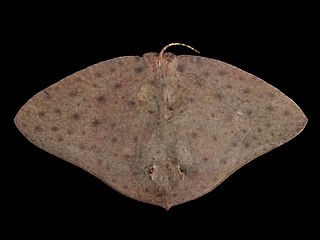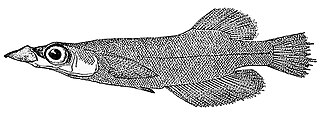
The ricefishes are a family (Adrianichthyidae) of small ray-finned fish that are found in fresh and brackish waters from India to Japan and out into the Malay Archipelago, most notably Sulawesi. The common name ricefish derives from the fact that some species are found in rice paddies. This family consists of about 37 species in two genera. Several species are rare and threatened, and some 2–4 may already be extinct.

Anablepidae is a family of fishes which live in brackish and freshwater habitats from southern Mexico to southern South America. There are three genera with sixteen species: the four-eyed fishes, the onesided livebearers and the white-eye, Oxyzygonectes dovii. Fish of this family eat mostly insects and other invertebrates.

The butterfly rays are the rays forming the genus Gymnura and the family Gymnuridae. They are found in warm oceans worldwide, and occasionally in estuaries.

Orestias is a genus of pupfish. Older systematics classified them into the own family Orestiidae. They are found in lakes, rivers and springs in the Andean highlands of South America, and several species are considered threatened. They are egg-laying fish that feed on small animals and plant matter. The largest species can reach a total length of 27 cm (10.6 in), but most remain far smaller. Their most characteristic feature is the absence of the ventral fin, although this is shared by a few other pupfish. Despite their moderate to small size, they are important to local fisheries and a few species are farmed.

Oryzias is a genus of ricefishes native to fresh and brackish water in east and south Asia. Some species are widespread and the Japanese rice fish is commonly used in science as a model organism, while others have very small ranges and are threatened. They are small, up to 8 cm (3.1 in) long, and most are relatively plain in colour.
Phallostethus is a small genus of fishes in the family Phallostethidae native to freshwater and brackish habitats in southeast Asia.

Phallostethidae, also known as the priapium fish, is a family of atheriniform fish native to freshwater and brackish habitats in southeast Asia.
The Indonesian featherback is a species of knifefish from freshwater habitats in Southeast Asia. The details of its range are not entirely clear, with FishBase reporting that it occurs in Sumatra, Borneo, and the Malay Peninsula, while Catalog of Fishes considers it endemic to Borneo.

Neostethus is a genus of fishes in the family Phallostethidae, native to freshwater and brackish habitats in southeast Asia, with the majority of the species restricted to the Philippines.

Adrianichthys is a genus of ricefishes. The genus is endemic to Lake Poso in Sulawesi, Indonesia. All four species are considered seriously threatened and two of these, A. kruyti and A. roseni, have not been recorded for decades, leading to fears that they already are extinct. Adrianichthys are larger than the Oryzias ricefish, reaching lengths of 8.5–17.1 cm (3.3–6.7 in) depending on the exact species involved. The name of this genus is a compound ending in the Greek ichthys for "fish" with the first part honouring the linguist and missionary Nicolaus Adriani (1865-1926), who collected specimens around Lake Poso.

Oxuderces is a genus of fish in the family Gobiidae native to fresh and brackish waters of coasts of the Indian and Pacific Ocean.

Diagramma is a genus of marine ray-finned fishes belonging to the family Haemulidae, grunts native to the Indian Ocean and the western Pacific Ocean. The currently recognized species in this genus are:

Genyatremus is a genus of marine ray-finned fish, sweetlips belonging to the subfamily Plectorhynchinae, one of two subfamilies in the family Haemulidae, it consists of four species. The name of this genus is a compound of genys meaning “chin”, a meaning “without” and tremus meaning “pore”, a reference to the lack of a central pore on the chin in the fishes in this genus.

Xenistius is a genus of grunts native to the eastern Pacific Ocean.

Haemulinae is a subfamily of the Haemulidae and consists of the genera of that family which are regarded as being of New World origin, although they are now widespread. The subfamily is distinguished from the Plectorhynchinae by having a short dorsal fin which contains 13-16 soft rays, as opposed to the long dorsal fin with 17-26 soft rays of the subfamily Plectorhynchinae.

Plectorhinchinae, is one of two subfamilies of the family Haemulidae, some known colloquially as sweetlips. This subfamily is regarded as having an Old World origin.

Phallostethinae is a subfamily of fishes, one of two subfamilies in the family Phallostethidae, the priapumfishes. The species in this subfamily are characterised mainly by having highly protrusible jaws. The genus Neostethus appears to be the sister taxon to the other two genera in the subfamily. The species in the Phallostethinae are found in south-east Asia, the Malay Archipelago and the Philippines.

Brachygenys is a genus of marine ray-finned fish, grunts belonging to the family Haemulidae. The species within the genus are found in the eastern Pacific Ocean and western Atlantic Ocean. It is not yet recognised by Fishbase but is by the Catalog of Fishes.
Rhencus is a genus of marine ray-finned fish, grunts belonging to the family Haemulidae. The species within the genus are found in the eastern Pacific Ocean. It is not yet recognised by Fishbase but is by the Catalog of Fishes.

Rhonciscus is a genus of marine ray-finned fish, grunts belonging to the family Haemulidae. The species within the genus are found in the eastern Pacific Ocean. It is not yet recognised by Fishbase but is by the Catalog of Fishes.














